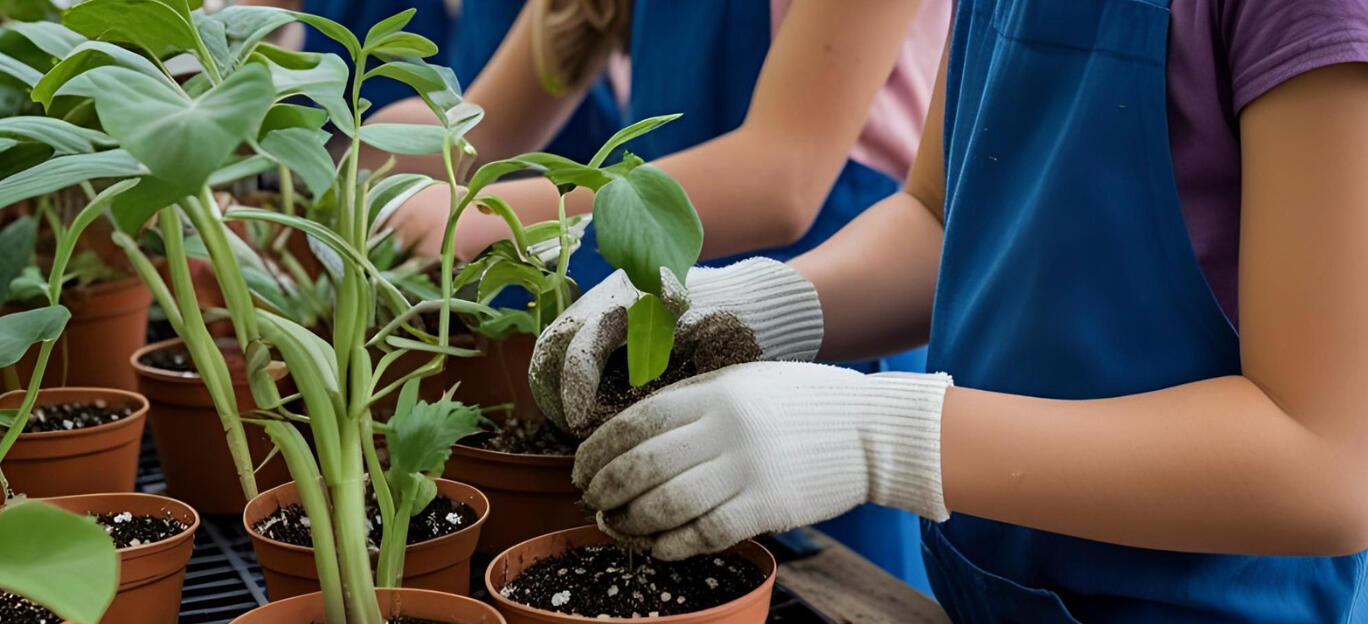Week 1 – Chia Champs 🌱 Introduction to botany: children learn about plant needs, soil types, growing mediums, and light/nutrient requirements. We start with a fun hands-on activity, feeling all the different types of mediums used to grow plants, then we'll make chia pets. Children can take these home (optional) and watch them grow.
Week 2 – Air Layer Adventure 🌿 Explore plant reproduction methods, focusing on air layering a woody plant. Children pair up to prep a stem section. Over 16 weeks, we’ll observe new plant growth from the stem.
Week 3 – Seed Sprint ❄️ Children learn seed parts and why some sprout immediately while others require cold or scarification. They plant seeds in labeled bags—some refrigerated, others at room temperature—and race to see which sprouts first.
Week 4 – Maple Mystery 🍁 Learn about local maple species—native, invasive, and ornamental. Children sort fresh and dried leaves, find the missing leaf for the Canadian flag, create their flag, and identify other maple types.
Week 5 – LECA Lab: Up or Down? ⬆️ Propagate snake plant leaf fragments in LECA (lightweight expanded clay aggregate). Children explore propagation basics, root development in LECA, and what happens when a cutting is planted upside down. Plants can be taken home.
Week 6 – Color Quest 🍂 Using leaf chromatography, children separate leaf pigments beyond green—yellow, orange, red—and learn how these pigments help plants capture sunlight and change with the seasons.
Week 7 – Microscope Safari 🔬 Children use microscopes to explore plant anatomy up close—cells, stomata, veins, and pollen. They examine leaves, stems, and roots to understand how each structure supports survival and connect form with function.
Week 8 – Leaf It to Grow 💧 Children propagate succulents in water from a single healthy leaf, learning how plants reproduce without seeds. They observe root growth and take their labeled water setups home (optional) to continue observation.
Week 9 – Orchid Oasis 🌸 Each child receives an orchid; together we check root health, remove substrate, and place the orchid in water. Children learn how orchids can survive and thrive in water alone.
Week 10 – Mini Ecosystems 🌧️ Building on the previous week, children create terrariums with orchids using layered media to simulate natural environments. Children have the option to take their terrariums home.
Week 11 – Bug Eaters & Movers 🪰 Explore carnivorous plants like Venus Flytrap, Pitcher Plant, and Sundew, along with the Sensitive Plant’s movement. Children learn about traps, sticky hairs, and digestive enzymes, observe leaf folding, and gently feed the plants!
Week 12 – Pollinator Pursuit 🐝 Children go on a scavenger hunt matching native Ontario plants like milkweed, goldenrod, and serviceberry with pollinator partners such as monarchs, bees, and hummingbirds. They learn how native plants support local wildlife and biodiversity.
Week 13 – Houseplant Hospital 🩺 Children explore houseplant care basics, identifying signs of thriving or distressed plants—leaf color, wilting, new growth, pests—and recommend care adjustments like watering, light, or repotting. We’ll also look at some common houseplant pests under the microscope.
Week 14 – The Thirsty Plant Race 💧 Children investigate capillary action and water cycle processes—precipitation, condensation, cohesion—using colored water and cut flowers. They observe water moving through plant tubes and can take flowers home to watch color changes. We’ll also check the Seed Sprint winners from Week 3.
Week 15 – From Parent to Plant 🪴 Children separate rooted sections from air-layered plants (Week 2), repot them with soil, and learn how vegetative propagation creates new plants. The new plants will be donated to the school garden.
Week 16 – Battle of the Botanists 🏆 In the grand finale, children compete in a Jeopardy-style quiz based on Pressed & Preserved: Ontario’s Plant Life, reinforcing biodiversity and plant ID skills. Winning teams receive prizes.
document.querySelectorAll(".program-question").forEach(item => { item.addEventListener("click", () => { const currentlyOpen = document.querySelector(".program-answer[style*='block']"); const answer = item.nextElementSibling; if (answer.style.display === "block") { answer.style.display = "none"; } else { if (currentlyOpen && currentlyOpen !== answer) { currentlyOpen.style.display = "none"; } answer.style.display = "block"; } }); }); 

 Botany can be a little hands‑on! Kids are encouraged to wear the provided gloves and apron. Some children love the sensory experience of soil and moss — others prefer to stay clean. Each child can choose what feels right for them.
Botany can be a little hands‑on! Kids are encouraged to wear the provided gloves and apron. Some children love the sensory experience of soil and moss — others prefer to stay clean. Each child can choose what feels right for them. 




